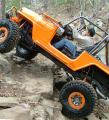
Originally Posted by
EagleMark

Sounds feasible. Don't need vacuum though, you have MAP kpa which is manifold pressure/vacuum.
I've done several rigs like yours without false knock issues, then had to turn off knock sensor because of off roading. Rock crawling in paticular, hit a rock on frame and get knock counts, loose timing and engine stability at idle. Not a good thing when rock crawling.
False knock from noise is always a possibility, but usually not vibration, usually a bang. Some good examples were a Third Gen Camaro with a rear axle control arm bushing and a pick up truck with things banging in bed.
Some things to remember with knock sensors is knock sensor has to match ESC module which matches engine CID. Knock sensor is installed with a torque setting, to tight, false knock. Can make it a little less sensitive for header noise with about 6 wraps of teflon tape, can also put it in a brass elbow. If the sensor was ever over tightened it's shot and always over sensitive.
There's a point where to much timing does not help and is hard to notice without a dyno, will cause detonation without knock, causes piston heat and failed rod bearings. There's a slope to MBT and you want to be on the up side to top not going down. For a street rig off roader there's way to many varibles to try and get this accurate, fuel from station to station, tempreture, humidity. If you get MBT and back off 4-6 degrees you'll have a long lasting safe spark table.
If your going to push this hard always run highest octane...




 Reply With Quote
Reply With Quote


Bookmarks